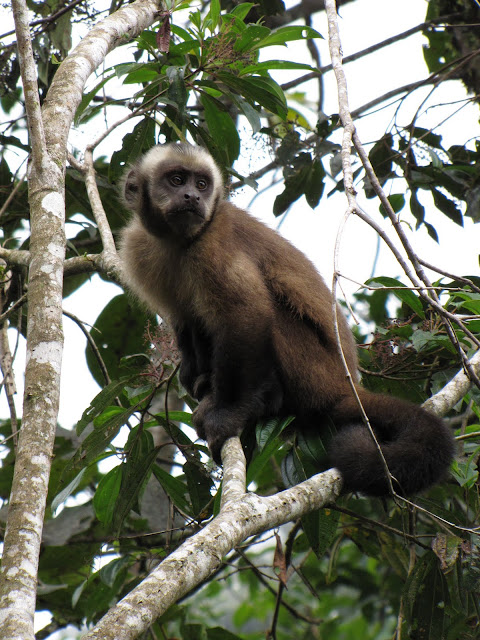May 22, 2010 (Day 4)
We're off to an early start this morning (4:30 am) as we pack into a van in a dark alley in Cusco (elevation: ~3,300m) and make our way to the Amazon Rainforest as part of Amazon Trails Peru's tour of Manu National Park.
According to the brochure,
According to the brochure,
Manu is situated in the Peruvian part of the Amazon basin and is one of the world's great wilderness areas where wildlife is still undisturbed and plentiful. The Manu Biosphere Reserve protects Tropical Alpine Grasslands (Puna), Elfin (temperate) and Cloud Forests, High Rainforest and Lowland Rainforest. In these different ecosystems we can find an extraordinary variety of animal and plant species: So far 15,000 plant species, over 1,000 bird species and 200 species of mammals have been identified in Manu. According to biologists, no other rainforest park can compare with Manu's biodiversity (40 % more bird species than in the Brazilian Amazon) and opportunities to observe wildlife. Manu is remote, away from civilization and scarcely populated, which distinguishes Manu from other rainforest destinations like Puerto Maldonado. Some of the indigenous tribes in Manu have no contact to civilization.
After a quick stop at a stand alongside the highway to pick-up our bread supply for the next six days, we soon make our way onto what appears to be a mining road that hugs the edge of a mountain range. The dirt road that started out with carefully placed stone dividers to differentiate the two lanes quickly turned into a single lane gravel road with barely enough room for one vehicle, let alone opposing traffic. This, of course, presented many interesting situations as you have mountain rock on one side and sheer cliff on the other side of the road, and transport trucks bullying their way down the road. Size definitely matters here. The bigger your vehicle, the more negotiating power you have when you come bumper-to-bumper with an opposing driver. The smaller vehicle usually had to reverse up to a few hundred meters to a wider stretch of the road (despite what common sense would otherwise dictate) to the point where we were only a few whiskers of the cliff's edge on several occasions. The winding road also presented the problem of blind bends so our driver honked the horn to warn oncoming traffic of our presence and this avoided problems for the most part. The vistas were spectacular and the risk of an imminent fall down the cliff provided a great adrenaline rush that I definitely wouldn't mind doing again!
Along the way, we stopped in Ninamarka. Luckily, I didn't jump into the "huts" for a photo as I had initially thought of doing as we later were informed that the site was a pre-Inca cemetery and those little "huts" we're actually tombs. Talk about listening to your gut instincts!
We then continued on our way to Paucartambo village, where we stopped for breakfast and a little sightseeing of the bridge and local market where they sold the most delicious bananas of the entire trip!
After reaching an elevation of over 4,000m, we were ready to descend the eastern slopes of the Andes
and enter the cloud forest where we passed through several tunnels, including one with an almost 90-degree angle turn which resulted in the van scrapping the side of the tunnel. While the crew was preparing our roadside picnic lunch, we ventured out for a walk and spotted Peru's national bird, the Cock of the Rock (Rupicola peruviana), within the lush vegetation of the cloud forest
and then sure enough, our first monkeys, only an arm's length away...
Landslides from the rainy season were evident throughout our afternoon drive and on several occasions, we had to get out of the van and walk a particular section of the road because the driver deemed it unsafe for us to stay in the van.
Considering all the close cliff-side calls earlier in the day in which we didn't evacuate the vehicle: When the driver says "Get out of the van", you get the fu@k out the van! No questions asked!
Late in the afternoon, we visited a small family-run coca leaf farm and over 12 hours after the start of our day, we arrived in Atalaya (elevation: ~500m). From here, a relatively quick 15 minutes boat ride took us to our home for the night, the Rio de Oro Lodge.
After a late candle-lit dinner, there was an optional night walk that we, of course, took part in. There's nothing like walking through the noisy rainforest in the darkness, relying on a few flashlights and keychain LED's to find your way around while spotting critters like poisonous tree frogs and wolf spiders by their eye reflections.
It was a long day yet it flew by like it was only a few minutes! Back to the lodge to get some sleep before our early departure in the morning.





















No comments:
Post a Comment